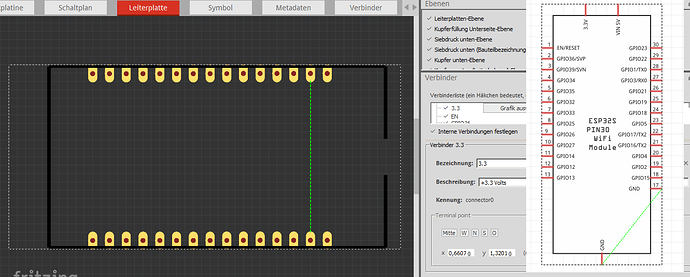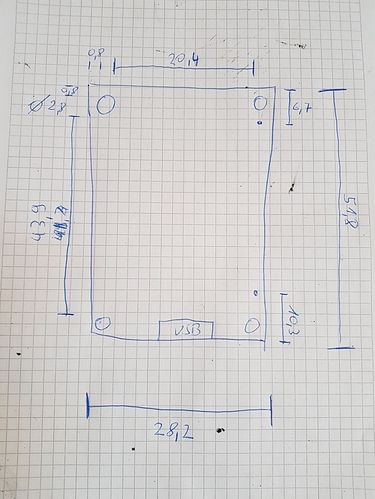Peter, thank you for crosschecking and your feedback.
You are absolutely right - it’s not 1100 mil. I messed it up: “11 pins width” are not more than 1000 mil. Any inaccuracy resulting in 997,9 in the Gerber comes from my nob-knowledge in Inkscape. However the pin-headers fit on my real PCB but as the presoldered pin-headers on my board are not soldered 100% perpendicular, this mismatch doesn’t have a big effect.
The hole/pad sizes come from the Sparkfun DIL 40 pin (as far as I remember). I did not change them in size. I just deleted one layer, deleted 10 pads/pins and renamed them. I had lot of problems to pick up the right graphics in PCB view for the connectors so it ended up, that the connectors are the rectangles and not the circles. I haven’t found any guideline that this is not allowed and it works (at least for me).
The connected pins are GND - therefore I decided to connected them internally (Pin 14 and Pin 17) in PCB view. In my opinion this should be ok.
Your indicated “It is preferable for schematic to have the same layout as breadboard” … there are a lot of modules where 5V/3.3V/VIN and GND are on the top/bottom of the schematic view. I liked that idea, therefore I did the same. I used the ESP32S-HiLetgo schematic SVG as starting point.
I don’t know why the “mouse over - in bracket numbering” doesn’t fit to anything else, but should I care? If I make a drawing in schematic view I connect connectors based on their naming (VIN, GPIO13…) and I do routing in PCB according to wiring, I never used the “in bracket numbering” for named parts where I have the pin names in clear text available.
The “overlapping” pads vs. silkscreen outline: I found the measurement of 28,3 x 51,5mm at the seller and started painting the PCB before the part arrived.
The “hole indicators” on the silkscreen are a good idea, i consider that for my next module (if I’ll ever make one). Currently I didn’t want holes as I needed a very small footprint part.
I can do a caliper measurement earliest during Christmas days.
P.S.: is there any up to date “Tutorial” / Guideline / Style-guide how to design parts? I just see a lot of “hints” in the forum but no actual description.


 ), if you could print the PCB svg at life size and compare the output to the real board to make sure the mounting holes and the header connectors in the pcb view match an actual board we should have a part that is ready to be submitted to core. I replaced the board one post back with the updated one so we don’t have multiple copies of the same board floating around. If it isn’t quite right, you can move the mounting holes and/or connectors in Inkscape (you probably have to ungroup the pcb svg to avoid translates though) until they match exactly, then I’ll update the pcb svg to match if needed.
), if you could print the PCB svg at life size and compare the output to the real board to make sure the mounting holes and the header connectors in the pcb view match an actual board we should have a part that is ready to be submitted to core. I replaced the board one post back with the updated one so we don’t have multiple copies of the same board floating around. If it isn’t quite right, you can move the mounting holes and/or connectors in Inkscape (you probably have to ungroup the pcb svg to avoid translates though) until they match exactly, then I’ll update the pcb svg to match if needed.